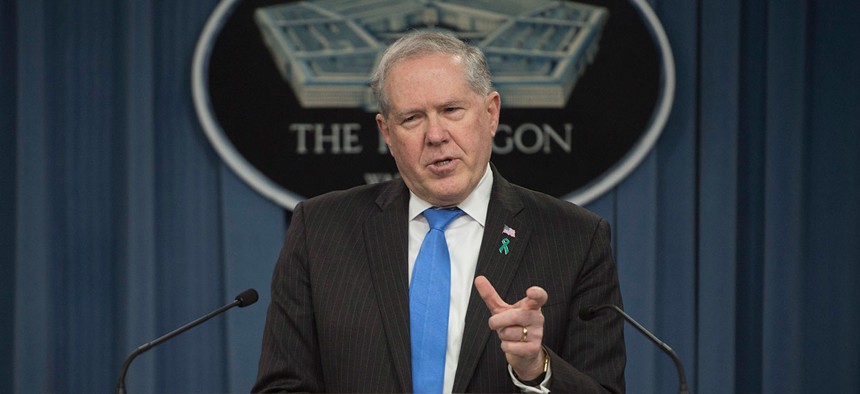Kendall: The Pentagon’s Spending Less on Weapons, So Let Me Keep My Job
A 30-year-low in cost growth is part of the defense acquisition undersecretary’s closing argument for why Congress shouldn’t eliminate his position.
Some political appointees spend the final months of a presidential administration counting the minutes until the inauguration. Frank Kendall is not one of them.
Rather than slip back into private life, it seems, the Pentagon’s undersecretary for acquisition, technology, and logistics would prefer to keep looking for ways to save money on weapons and military equipment.
“Not much longer,” a reporter said to Kendall during a briefing at the Pentagon on Friday.
“We’ll see,” Kendall said with a smirk.
But even the next president might not have the final word on whether to keep Kendall in his E-Ring office. A provision in the Senate version of the 2017 defense authorization bill would eliminate Kendall’s undersecretary position. The House version does not contain the provision, and the two houses are expected to iron out their differences after next month’s elections.
In the meantime, Kendall has published what might be his final progress report on the Pentagon’s $1.6 trillion arms-buying portfolio. It might also serve as his best argument for keeping his job intact: the data shows that his policies have decreased cost growth in weapons projects.
“The last six years of work that we’ve put into this while I’ve been back in the Pentagon has paid off,” Kendall said. “We are at a 30-year low in cost growth on our major acquisition programs and we reversed a trend that was in the opposite direction. That’s a pretty big deal.”
In 2010, Kendall’s predecessor, now-Defense Secretary Ash Carter, created Better Buying Power, a series of initiatives to get the Pentagon more for its money. Kendall updated the guidelines twice and has recently said he would look to do a fourth version if he remained into the next administration.
“I’m convinced this is real and I’m convinced it correlates to the things we’ve been doing. There are other factors, there always are, but I think that the evidence is pretty clear that we’re moving in the right direction,” he said.
When Carter started Better Buying Power, new weapons programs were busting their early-development-and-production budgets by an average of 9 percent. That rate has since fallen to about 3 percent.
While “most areas continue to look good,” Kendall has his concerns — mainly the lack of competition for contracts. (It’s no secret that there are fewer new arms projects after a decade of record-high defense spending.)
“I don’t think we’re putting as many new products into the new product pipeline as we should be,” he said.
The controversial legislation, written by Armed Services Committee chair Sen. John McCain, would eliminate the post of undersecretary for acquisition, technology and logistics and create two new undersecretaries, one for research and engineering and one for management support.
Does Kendell think his report bolsters the case against eliminating his job?
“I think abolishing my position in the face of that [report] is probably a bad decision,” he said. “I think my position has worked successfully. I think the Secretary of Defense needs someone in the Secretary of Defense’s office who can effectively oversee service acquisition programs for him. I think that’s a very important feature of how anybody would want to organize the Department of Defense.”




